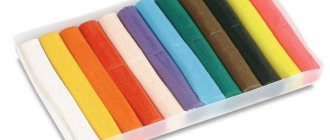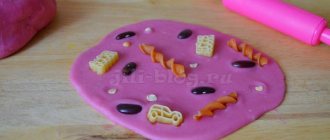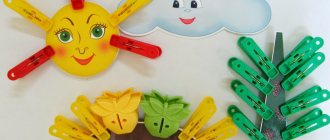What is the use of clothespins?
Ordinary clothespins can become an excellent play simulator and educational aid if you show a little imagination.
What can you use clothespins for?
- For the development of fine motor skills.
- Studying color.
- Speech development.
- Studying the account.
- Studying flowers.
- Sensory development.
- Fantasies.
- Imaginations.
- In memory.
- Attention.
- Grasping skills.
- Flexibility of the hands.
In addition, it should be borne in mind that children, from about 8 to 9 months old, enjoy tinkering with household objects much more than with toys. Cereals, cans, bottles, spoons, dishes, dad's tools, and clothespins, among others, keep kids occupied easily and for a long time.
Moreover, clothespins are much more “magical” than anything else: you can not only knock against each other, take or move them, but also bite, grab, and pinch. Parents can successfully use this fact by organizing games with clothespins - simple or using additional materials.
Build paths from dominoes
This may seem surprising to some, but a one-year-old child can already play dominoes! Of course, while there is no need to explain detailed rules to the child, tell him what a “bazaar” and “fish” are, he is unlikely to be interested in this. But the domino principle itself, based on the selection of identical pictures, can easily be grasped by a child.
To play, you will need a children's domino with pictures that the baby can understand (for example, we have this, other options are Ozon, My-shop). Explain to your child that you can build paths (or fences, as you prefer) from dominoes. But the paths are not simple: the dominoes in them must be selected so that the pictures on the edges match. Taisiya and I used dominoes to build a large fence, inside of which some animal would definitely live. Tasya could play dominoes on her own for a long time.
How to play with kids?
For the youngest children, the clothespin itself is already a toy. She can “quack” like a duck, “croak” like a frog, “bite” like a crocodile, “bark” like a dog (with the help of her mother, of course). By about one and a half years, a child will already be able to remove clothespins from various surfaces. You can take advantage of this and offer your baby the simplest games:
- “Bite” the child (only carefully) on different parts of the body (you can call them at the same time), saying that this is a crocodile who asks, for example, to be pitied.
- Attach multi-colored clothespins to yourself or to your baby, inviting him to remove these “annoying bugs.” The baby will easily succeed and will delight.
- When the child leaves the room, attach the “bugs” to different objects and ask him to find them all and remove them.
- Assemble a snake from several clothespins - the baby will be happy to take it apart.
Choose clothespins that have already been worn out and close weakly - they will not hurt the baby if he accidentally pinches his finger.
Closer to 2 years, you need to teach your child how to use such a toy independently: show how to hold it with three fingers, how to press to open it, how it closes when the fingers are released. After some training, the child will be able to do this himself. This means that you can move to a new level of games when the baby independently fastens the clothespins. Now they can turn into construction sets, colorful beads (if you string them on a string), hairpins and clips for doll hairstyles, even an abacus (also on a string, but the principle of the game is the same as when working with abacus). And they can also fulfill their role if the child washes the doll’s clothes and begins to hang them out to dry.
Simple educational games with clothespins
For these games you don't need anything other than the clothespins themselves. Well, or almost nothing.
Remove the bug from your clothes.
Attach clothespins of different colors to yourself or your child and invite him to remove the bug. This is a fun game with which you can consolidate your knowledge of basic colors, body parts, clothing, and learn the concepts of “right” and “left” (right hand, left leg).
You can also run after dad together and save him from annoying bugs. Or run away from them yourself.
Find the bug.
Ask your child to wait for you in another room, and you yourself attach clothespins to various objects - curtains, toys, furniture, etc. Tell your child that while he was away, bugs arrived and now they need to be caught and put in a box or bucket.
The game perfectly develops attention and is ideal for the first games, when the child’s fingers cannot yet attach clothespins.
This is a very fun game. The children adore her. You can run, train your arms, and show off your catch. You can also count the caught bugs. This is how we play - we are looking for 3 bugs.
When the child’s fingers get stronger, invite him to plant bugs, and you will look for them. But my experience shows that children like the first version of the game more.
Drying clothes . Your child has probably seen you hanging out laundry after washing more than once. Children love to repeat after adults! If you tie a rope between the legs of the table or even the handles of the basin, with what joy the baby will hang out his socks or clothes for the dolls!
Beads from clothespins . Clothespins can be strung on a cord to make beautiful beads for mom. When the child can easily cope with the task, complicate the task and invite him to alternate clothespins of different colors.
We attach it to everything . Attach clothespins with your child to everything that comes to hand. Make earrings for a bear, decorate a hanger, plastic cups, a car, and designer parts.
Antoshka likes to attach clothespins around the perimeter of the box in which we store them. And if you cover the box with colored paper (each side has a different color), then this is another reason to repeat the primary colors.
Designer parts can be used for the same purposes .
Magic toy
This is true. Clothespins, if attached to the appropriate blanks, can be transformed into anything at the request of the players:
- into raindrops;
- the lights of a sun;
- legs or arms of characters;
- tree branches;
- antennae of animals or insects;
- animal ears;
- wings or tails of birds;
- tops of root crops;
- flower petals;
- fish fins, etc.
You can make a whole clothespin theater with your own hands with such details, or the open halves of clothespins can play the role of the opening mouth of the characters. Both favorite fairy tales and simple stories are played out: it’s raining, a bear is eating raspberries, a doll is picking flowers, etc. Playing nursery rhymes, tongue twisters, and nursery rhymes in this way will make learning them much more productive, because it’s exciting.
Invite your child to build a fence out of clothespins so as not to waste construction kit parts on it - they will be used to make other objects.
Learning letters and numbers for a preschooler will also become much more interesting if they are given arms and legs from clothespins and involved in various adventures (for example, the letters A and M constantly come to the baby for lunch so that he says “Am”; the evil Minus took it away from Troika One, and it turned into Two).
Letters or numbers can walk, jump, dance, fall, hold on to handles... Imagination can suggest many options for transformations for clothespins.
Use a sponge to pour water from one bowl to another
The game is in many ways similar to the previous one, but still gives the child slightly different sensations. A few tips: firstly, place a bowl of water on the left and an empty bowl on the right , then the child will pour water from left to right, this direction of action is important for placing his hand before writing. Secondly, it should be noted that it is more convenient to play with a sponge that is completely soft (without a hard part); if you were unable to buy a soft sponge, then cut off the hard part with a knife.
Educational games
By preparing the necessary pictures or pieces from cardboard, you can achieve a more global goal than just a game: teach your child much of what is necessary for studying at school. By the way, such manuals are successfully produced and used in kindergartens. Here are some examples of such games and activities:
- Cut out a cardboard circle, mark it into several segments, paint each one a different color. In each segment, draw several points - from 1 to 5 - 9 (depending on the age of the child). Let him attach clothespins of the corresponding colors according to the number of these points. (We learn numbers, counting, colors).
- For the same purpose, you can play parcels for hedgehogs. Make several blanks of hedgehogs of different colors, write a specific number on each of them. This is exactly how many clothespins of the desired color the baby should attach instead of needles. Then he needs to collect the same number of cardboard apples of the desired color into a parcel for the corresponding hedgehog.
- Using the same principle, you can go fishing (the clothespins will be fish of different colors, you need to catch them and put them on mugs of the corresponding colors in the quantity indicated on the mug).
- The blank is also a circle made of cardboard. Only in each segment the food of different animals or birds will be drawn. Stick animals on one side of the clothespin in accordance with the food presented. The child’s task is to feed them by attaching them to the desired sector of the circle. (We study the world around us).
- Show your baby several identical objects of different sizes (these can be cards with images, things or toys - whatever will be more interesting for a particular baby). The baby’s task is to attach 1 clothespin to the smallest (low, short) object, then in ascending order 2, 3,4... (We study the values).
- Pronounce any word syllable by syllable, and let the child attach as many clothespins to a sheet of cardboard as there are syllables he can count. (Developing speech and phonemic hearing).
- Make preparations of various root vegetables (carrots, beets, turnips, radishes), “plant” them in a box with small grains (vegetable garden). The kid needs to use clothespins to “harvest the harvest”, because all the tops were eaten by pests, and it became not so easy to pull out the root crops. (We develop fine motor skills and horizons).
If parents have a developed imagination, they themselves will be able to come up with dozens more options for using such simple materials at hand for educational activities with their child.
It is possible that, having become involved in the process, the baby himself will suggest new possibilities. The main thing is not to suppress his creative impulses, to remain helpers, advisers and loving friends. Then not only clothespins, but everything that is at hand can be used. And this is a new level of development of the child’s imagination, as well as his relationship with his parents: they become allies, and not just play partners. And it all started with an ordinary clothespin...
Make a picture using puzzle cubes
If your child is already familiar with simple puzzles, now you can invite him to assemble a picture on puzzle cubes (of 4 parts) (Labyrinth, Ozon, My-shop). This task is a little more difficult, because here, before placing the cube in the right place, the child must also turn it and find the appropriate side. At first, of course, you will have to twist the cube to find the right side, but while you are doing this, explain to your baby why you chose one side or another.







